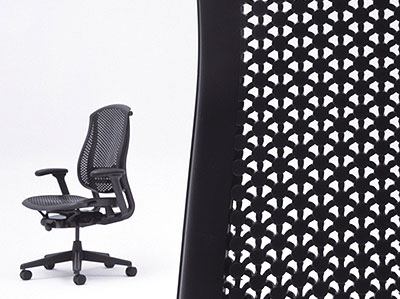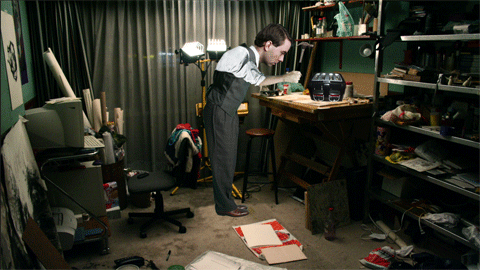A $200 Desk Chair

My mother bought me this $60 used purple foam desk chair my freshman year of college, and I kept it for 10 years. It was quite comfortable, but the springs were so worn out that it was almost impossible to keep it level. So I recently went on a quest to find a replacement that wouldn’t break the bank. Since most of you reading this are sitting on office chairs, I thought I would share some of the things I learned.
I started at the top. I’ve sat on my share of fancy chairs in fancy offices over the years, and I know how comfortable those Herman Miller chairs are. The Aeron is nice, but I spent this spring sitting in one of their newer and less expensive Celle chairs. Rather than a soft mesh they have an unusual network of plastic circles. Despite the harder look of it, it’s really quite lovely to sit in all day. I prefer it to the Aeron. I went to Design Within Reach in Brooklyn Heights to check out the other fancy chairs available. The Humanscale Liberty won Slate’s desk chair round-up a few years ago, and I can tell you it is quite comfortable as well. But at $1000 it was well out of my price range. Nothing at Design Within Reach was what I would consider “Within Reach” so I headed downscale.
I spent some time sitting on chairs at my local Staples, but nothing really felt sturdy and comfortable. It was also impossible to get a salesperson to help me out. I spent a lot of time online, and wasted a lot of energy trying to find an inexpensive all-mesh chair because I was sure that was the best option. I ended up ordering a Super Mesh Office Chair from Bizchair that was extremely solid, and well-constructed, but the metal frame around the mesh seat dug into the back of my legs because I was too short for it, and the mesh seat was surprisingly hard on the butt. The armrests also felt flimsy. They’re adjustable in a way that never really locks in place and they always jiggled a little when I used them to move the chair.
So rather than disassemble it and pay for the round-trip shipping, I sold it on Craigslist to a much taller man, for a slight loss.
At that point I realized that it is in fact necessary to sit in a chair before you buy it. So I headed over to Office Furniture Heaven on 19th St. in Manhattan. I spent about an hour moving from chair to chair, experimenting with every combination of mesh, foam, and mesh-foam. There was an inexpensive all-mesh Raynor Apollo chair with a plastic frame that appealed to me, but even though it had an adjustable-depth back, the frame on the seat still dug into my legs a little. It seems like cheap mesh seats are not a good idea. I could imagine what it would be like in 10 years. I suspected it would not hold up as well as the old Purple Beast did.
 Although by that time I had settled on a $400 price cap, I did spend a lot of time sitting in a Raynor Ergohuman mesh chair. It is highly adjustable, comfortable, stylish, and feels like it will hold up well under lots of sitting. MSRP is over $1000, but you can get it online for less than $500. I probably would have bought the Ergohuman if Raynor didn’t also make an Apollo chair with a foam seat. It combined a surprising amount of adjustment with a comfortable seat and a $215 price-tag. In addition to the usual seat-height adjustments, there are very simple back-height, back-depth, and seat-tilt adjustments. The seat even tilts forward if you like that sort of thing. I’ve had it for about a month now and I’m very happy with it.
Although by that time I had settled on a $400 price cap, I did spend a lot of time sitting in a Raynor Ergohuman mesh chair. It is highly adjustable, comfortable, stylish, and feels like it will hold up well under lots of sitting. MSRP is over $1000, but you can get it online for less than $500. I probably would have bought the Ergohuman if Raynor didn’t also make an Apollo chair with a foam seat. It combined a surprising amount of adjustment with a comfortable seat and a $215 price-tag. In addition to the usual seat-height adjustments, there are very simple back-height, back-depth, and seat-tilt adjustments. The seat even tilts forward if you like that sort of thing. I’ve had it for about a month now and I’m very happy with it.







 When I graduated from college, my dad and his wife gave me a 16mm Bolex camera from the 1950s. It was a neat gift, but the really unique thing about it was the Stereo Kit that came with it. It was a complete set of stereo lens, projector lens with polarizing filters, and a small silver projection screen. The system works by putting two tall, skinny images side by side on each frame of film. Then when it’s projected, they are offset and overlapped with each one polarized differently, just like a fancy new 3-D movie. Rather than being widescreen though, the image is tall and skinny. Unfortunately in the past I haven’t had the time and money available to get the system going.
When I graduated from college, my dad and his wife gave me a 16mm Bolex camera from the 1950s. It was a neat gift, but the really unique thing about it was the Stereo Kit that came with it. It was a complete set of stereo lens, projector lens with polarizing filters, and a small silver projection screen. The system works by putting two tall, skinny images side by side on each frame of film. Then when it’s projected, they are offset and overlapped with each one polarized differently, just like a fancy new 3-D movie. Rather than being widescreen though, the image is tall and skinny. Unfortunately in the past I haven’t had the time and money available to get the system going.